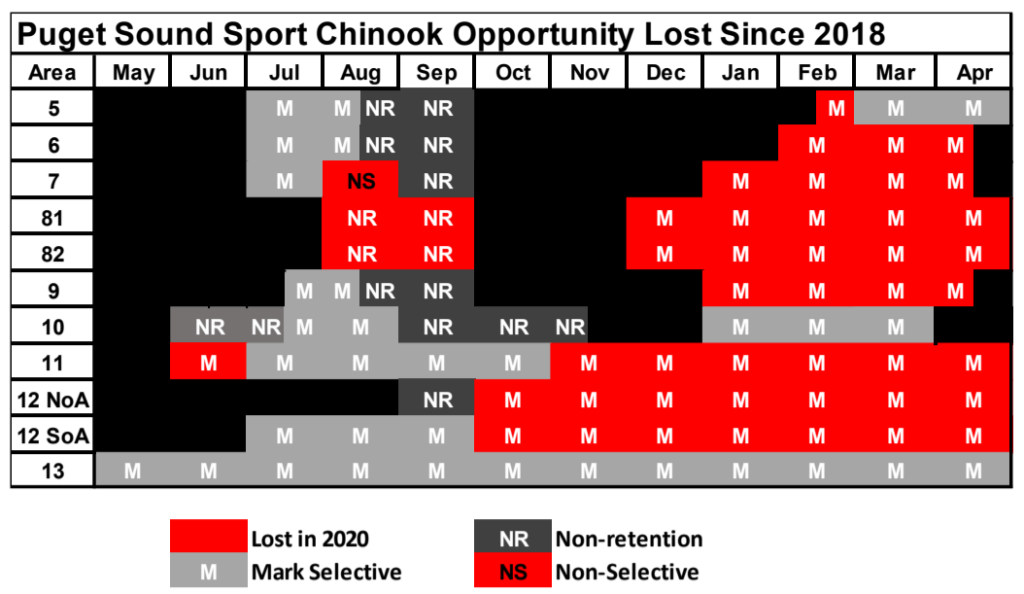
The co-managers, not NOAA, have insisted the Stillaguamish hatchery indicator stock be managed to a 12% cap. It is this cap on exploitation that drove the severe cuts to Marine Area 7 and the rest of Puget Sound, not necessarily the concentration of Stillaguamish hatchery fish in certain Marine Areas. For two years now, the state has agreed to manage the Stillaguamish indicator stock to this much more constrained level than it had in previous decades. Had this management limit not been in place, the age composition anomaly which appeared this year would not have triggered such deep cuts because no thresholds would have been exceeded. WDFW was warned by technical experts that allowing this unnecessarily low limit, which was not insisted on by NOAA to meet ESA requirements, to remain in place had the potential to be disastrous to Puget Sound fisheries. The Department made verbal assurances that this would not happen. They made these assurances based on their models even though those same models (which were based on the new FRAM base period implemented in 2017), showed the most limiting Chinook stock to be the Stillaguamish hatchery stock. That stock is found in large quantities throughout the year in Marine Area 7, and this is why Marine Area 7’s fishing season was severely cut last year, resulting in the complete closure of August. It is also why Marine Area 7 season was further cut this year. This year’s cuts should be not classified as a one-year anomaly based on an age group composition issue because as we saw last year, it does not take this kind of event to trigger massive reductions to our fishery.
During the 2020 North of Falcon process, WDFW offered to solve much of the problem associated with hatchery fish from the Stillaguamish River. The solution was to move the minimum size that fishermen could keep from 22 inches to 28 inches just in Marine Area 7, not the entire Puget Sound. Of note, the agreed-to mortality rate on a released chinook salmon caught on a hook-n-line is 15%, and this number was taken into account with the size limit change proposal. Data showed that by adopting a size limit of 5 inches above the current 22 inches that change would have saved Stillaguamish hatchery chinook salmon, and prevented much of the deep cuts to the recreational fishing season for 2020. The co-managers rejected this solution.
In 2014, WDFW began heavy reductions in chinook fishing opportunities in order to comply with NOAA-mandated conservation objectives. Back then, the Lake Washington and Mid Hood Canal stocks were really driving cuts (cuts mandated so as to be in compliance with NOAA’s guidelines for recovery of Endangered Species Act (ESA) listed stocks). These two stocks were concentrated in the mid to southern portion of the Sound, and so the majority of the restrictions or cuts were made to MA 9-10. But in 2014 the focus of cuts shifted north, and have by and largely remained there ever since. In 2014 WDFW began by converting Marine Area 7’s October fishery from non-selective (able to keep non-clipped chinook) to a selective fishery (having to release of non-clipped fish). Over the next six years, MA 7 chinook fishery was the center of the most drastic cuts to Puget Sound. The Area’s season went from eight months of non-selective chinook fishing in 2014 to likely two weeks of selective chinook fishing in 2020, a 92% cut to fishing recreational opportunity. What’s more, in 2020 not only were summer quotas cut in all Marine Areas, but the winter season was completely closed in Marine Area’s 6, 8-1, 8-2, 9, and 10. The cuts and closures were all in response to a limit not imposed on the state by NOAA, but by the co-managers.
